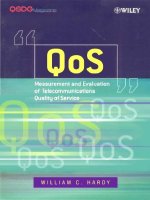John wiley sons qos measurement and evaluation of telecommunications quality of service (2001)
Bạn đang xem bản rút gọn của tài liệu. Xem và tải ngay bản đầy đủ của tài liệu tại đây (1.08 MB, 245 trang )
QoS
Measurement and Evaluation of
Telecommunications Quality of
Service
QoS
Measurement and
Evaluation of
Telecommunications
Quality of Service
William C. Hardy
WorldCom, USA
JOHN WILEY & SONS, LTD
Chichester · New York · Weinheim · Brisbane · Singapore · Toronto
Copyright q 2001
by John Wiley & Sons. Ltd
Baffins Lane, Chichester,
West Sussex, PO19 1UD, England
National 01243 779777
International (+44) 1243 779777
e-mail (for orders and customer service enquiries):
Visit our Home Page on or
All Rights Reserved. No part of this publication may be reproduced, stored in a retrieval system, or
transmitted, in any form or by any means, electronic, mechanical, photocopying, recording, scanning or
otherwise, except under the terms of the Copyright Designs and Patents Act 1988 or under the terms of a
licence issued by the Copyright Licensing Agency, 90 Tottenham Court Road, London, W1P 9HE, UK,
without the permission in writing of the Publisher, with the exception of any material supplied specifically for the purpose of being entered and executed on a computer system, for exclusive use by the
purchaser of the publication.
Other Wiley Editorial Offices
John Wiley & Sons, Inc., 605 Third Avenue,
New York, NY 10158-0012, USA
WILEY-VCH Verlag GmbH
Pappelallee 3, D-69469 Weinheim, Germany
John Wiley & Sons Australia, Ltd, 33 Park Road, Milton,
Queensland 4064, Australia
John Wiley & Sons (Canada) Ltd, 22 Worcester Road
Rexdale, Ontario, M9W 1Ll, Canada
John Wiley & Sons (Asia) Pte Ltd, 2 Clementi Loop #02-01,
Jin Xing Distripark, Singapore 129809
British Library Cataloguing in Publication Data
A catalogue record for this book is available from the British Library
This title is also available in print as ISBN 0471499579
Typeset in Times by Deerpark Publishing Services Ltd, Shannon, Ireland
For Adriana
Contents
Preface
Foreword
Introduction
xi
xiii
xv
Part I Basic Concepts
1
Chapter 1 Definitions
1.1 Quality of Service
1.1.1 Intrinsic vs. Perceived Quality of Service
1.1.2 Perceived vs. Assessed Quality of Service
3
3
6
8
Chapter 2 Measurement and Evaluation
2.1 Function of Measurement and Evaluation
2.1.1 Audience and Utility
2.2 More Definitions
2.2.1 Data vs. Information
2.2.2 Measures vs. Quantifiers
2.2.3 Concerns
2.2.4 Objectives
9
10
10
14
15
16
17
18
Chapter 3 The Analysis Process
3.1 Phase 1: Formulation
3.1.1 Identify the Audience
3.1.2 Determine Decision-Making Responsibilities
3.1.3 Specify Analysis Objectives
3.1.4 Identify Concerns
3.1.5 Define Measures
3.1.6 Select Quantifiers
3.1.7 Example
3.2 Phase 2: Data Handling
21
21
22
23
23
23
25
26
26
28
Contents
viii
3.2.1 Data Acquisition
3.2.2 All the Statistics You Need to Know to Read this Book
3.2.3 Data Organization
3.2.4 Data Manipulation
3.3 Phase 3: Evaluation
28
29
33
38
40
Chapter 4 Telecommunications Concepts
4.1 Basic Systems and Processes
4.1.1 Injection/Extraction
4.1.2 Encoding
4.1.3 Routing
4.1.4 Signaling Systems
4.1.5 Switching Systems
4.1.6 Types of Service
4.1.7 Types of Connections
4.1.8 Set Up
4.1.9 Billing Method
4.2 Basic User Concerns with Service Quality
4.3 Preview
47
47
49
49
50
51
52
52
54
54
55
56
57
Part II Evaluative Concepts, Measures, and Quantifiers
61
Chapter 5 Overview
63
Chapter 6 Accessibility
6.1 Evaluative Concepts
6.1.1 Examples
6.1.2 Variations with Type of Service
6.2 Intermittently Used Services
6.2.1 Concerns
6.2.2 Generic Measure
6.2.3 Quantifier
6.2.4 Availability vs. Accessibility
6.2.5 Adjustments of OCC Axis Values using D[SO,SI|ty]
6.2.6 Evaluation
6.3 Continuously Used Services
6.3.1 Concerns
6.3.2 Measure
6.3.3 Quantifiers
6.3.4 Evaluation
65
65
65
68
68
69
70
75
81
84
84
84
85
85
86
90
Chapter 7 Routing Speed
7.1 Evaluative Concepts
7.2 Circuit-Switched Services
7.2.1 Concerns
7.2.2 Measure
7.2.3 Quantifiers
7.2.4 Evaluation
7.3 Packet-Switched Services
7.3.1 Concerns
93
93
94
94
95
96
99
117
117
Contents
7.3.2 Measures
7.3.3 Quantifiers
7.4 A Note on Data Acquisition
ix
119
119
119
Chapter 8 Connection Reliability
8.1 Evaluative Concepts
8.2 Concern
8.3 Measure
8.4 Quantifiers
8.4.1 Perceived QoS
8.4.2 Voice
8.4.3 Intrinsic QoS
8.4.4 Answer-Seizure Ratio (ASR)
8.5 Evaluation
8.5.1 Assessment of Likely User Perception of Quality
8.5.2 Assessment of Intrinsic QoS
8.5.3 Diagnosis
8.5.4 Monitoring
121
121
122
122
123
123
124
126
131
131
131
133
134
135
Chapter 9 Routing Reliability
9.1 Evaluative Concepts
9.2 Concern
9.3 Measure
9.4 Quantifiers
9.4.1 Perceived QoS
9.4.2 Intrinsic QoS
9.5 Evaluation
141
141
143
143
143
143
144
144
Chapter 10 Connection Quality – Voice
10.1 Background
10.2 Evaluative Concepts
10.3 Concerns
10.4 Measures
10.5 Service Attribute Tests
10.6 Quantifiers
10.6.1 Perceived Connection Quality
10.6.2 Intrinsic Connection Quality
10.6.3 Evaluation
147
147
149
152
152
154
156
156
157
157
Chapter 11 Connection Quality – Data
11.1 Evaluative Concepts
11.2 Concern
11.3 Measure
11.4 Quantifiers
11.4.1 Dedicated/Circuit-Switched Set Up
11.4.2 Store-and-Forward Relay
11.5 Evaluation
161
161
162
163
163
163
165
168
Chapter 12 Connection Continuity
12.1 Evaluative Concept
12.2 Concern
169
170
171
Contents
x
12.3 Measure
12.4 Quantifiers
12.4.1 Perceived QoS
12.4.2 Intrinsic QoS
12.5 Evaluation
171
171
171
171
172
Chapter 13 Disconnection Reliability
173
Chapter 14 The Other Stuff
14.1 Evaluative Concepts
14.2 Typical concerns
14.3 Service Level Agreements
14.4 Quality vs. Economy
175
175
177
177
187
Afterword
191
Appendix A
193
Appendix B
205
Appendix C
211
Abbreviations
217
Index
225
Preface
Most people know that quality of service (QoS) in telecommunications has
grown in importance over the past decade. This is thanks to the new competitive environment which has followed as a direct result of privatization and
de-regulation, forcing companies to increase the quality of their networks and
services. Yet QoS means different things to different people. In some developing countries where it is a struggle for QoS managers to wrestle with outdated equipment, even making a network perform in the way it was designed
is an improvement in QoS.
The Quality of Service Development Group (QSDG) is a field trial group of
QoS professionals from over 130 carriers, service providers, research companies and vendors from around the world. While informal, we operate under the
auspices of Study Group 2 of the ITU-T. We gather annually in different
geographic regions to discuss QoS issues within our companies. QSDG Magazine (www.qsdg.com) which as well as being our group’s official magazine, is
also the only periodical in the world about QoS, and is distributed in 201
countries and territories.
William C. ‘‘Chris’’ Hardy is unquestionably among the leading lights in the
field of QoS. As chairman of the QSDG I appreciate the contributions Chris
has made, both to the QSDG group as a whole, and through his QDSG Magazine column Telecom Tips and Quality Quandaries, on which much of this
book is based. If you are coming to grips with QoS in your company, this is the
place to start.
Luis Sousa Cardoso
QSDG Chairman
VU/Marconi
Lisbon, Portugal
January, 2001
Foreword
My involvement in analysis of quality of telecommunications services began
almost by accident in June, 1967, when I started my first full-time job out of
graduate school. The job was with the Operations Evaluation Group of the
Center for Naval Analyses. It seems that what they happened to need the day I
reported was someone to fill a slot as a communications analyst. Since I was
there, I was anointed, never mind that I knew absolutely nothing about telecommunications systems, electrical engineering, or even electricity, since I
had skipped that part of the college physics curriculum, and almost nothing of
my graduate education in mathematics was relevant to understanding Navy
tactical voice and teletype communications over radio frequency channels.
Because my career started with such a complete lack of practical experience
and technical skills, my analytical efforts have never been marred or impeded
by technical expertise or conventional wisdom. Rather, what I discovered was
that all I really needed to do to be effective as a problem solver in this area was
to:
† Imagine myself using the system I was studying;
† Decide what I would be concerned about if I were using it;
† Research the technology of the system to the extent necessary to understand the mechanisms affecting performance of the system with respect to
those concerns; and
† Formalize the relationships between system performance and user perception of quality of service gleaned from this drill.
When I did this, everything else needed to solve the problem would readily
follow – the user view would suggest concerns; concerns would suggest
measures of quality and effectiveness; understanding of the mechanisms
xiv
Foreword
would suggest measures of performance and their relationship to measures of
quality; measures would suggest quantifiers; quantifiers would suggest data
requirements; and so on, all the way down the analytical chain.
This book is based on more than 30 years experience in successfully applying this approach in analyzing issues of quality of service of telecommunications systems to produce practicable solutions to quality problems. Because of
the very basic nature of the approach, this book is apt to be viewed by some as
being short on technical content and long on formulation of evaluative
concepts and generic measures. However, I refuse to apologize for this,
because the perspectives on quality of telecommunications services that I
am trying to lay out here are exactly those that I would want all of my
employees to share, were I ever to become the CEO of a telecommunications
company, so that, for example:
† My marketing and sales forces would know how to communicate with
customers in a way that would demonstrate their understanding of customers’ concerns;
† My system engineers would know how to design my networks to satisfy
customer expectations, rather than simply meet industry design standards;
† My operations managers would know the comfortable levels of performance affecting quality of services that must be achieved and maintained
to assure user satisfaction;
† My service technicians would know how to troubleshoot user complaints
with the same competence that they identify, diagnose, and correct technical problems; and
† Everyone involved anywhere in the company would have a very good idea
of exactly how their day-to-day activities affect user perception of the
quality of our services.
To this end, what I have tried to present here is a treatise on the ways and
means of measuring and evaluating telecommunications services that is
simple and straightforward enough to be appreciated by anyone, but sophisticated enough to be informative and useful to telecommunications professionals. The only way you can judge whether I have succeeded is to turn the
page…
William C. Hardy
WorldCom, USA
Introduction
The purpose of this book is to define and describe a family of measures of
quality of telecommunications services that have been demonstrated in their
successful application over many years to be useful both to telecommunications service users, as a basis for understanding and assessing possible differences between competing services, and to service providers, as a means of
determining what improvements in service performance are needed to assure
customer satisfaction. The distinguishing characteristic of these measures is
that they have in every instance been designed to simultaneously achieve two
ends:
1. The credible, reliable assessment of the likelihood that users will find a
particular service to be satisfactory; and
2. The determination of how system performance must be changed when that
assessment shows that users are not likely to be satisfied.
This kind of complementary utility in a measurement scheme is not hard to
achieve. However, it is, in fact, frequently absent in proposed quality of
service (QoS) metrics, because definition and development of particular
measures have failed to take into account both the concerns of the users of
telecommunications services and the perspectives of the engineers and technicians who must design, build, and operate the systems that deliver those
services. It is, therefore, a secondary, but equally important objective of this
book to describe the analytical perspectives and discipline that have reliably
guided the development of the specific measures that are presented here.
To this end, the material in this book is divided into two parts:
† Part I presents the concepts and perspectives that have guided the development of the measures. This section first presents what might be thought
of as a theory of measurement. It begins with an examination of the possible reasons for developing measures and proceeds with a formal descrip-
xvi
Introduction
tion of the process by which the measures discussed here were developed.
This part of the book also contains a chapter that briefly defines and
describes basic telecommunications functions and the processes by
which those functions are used to deliver telecommunications services.
† Part II then discusses a complete family of measures of QoS of telecommunications services, keyed to the user concerns and different types of
telecommunications services defined in Part I.
Under this organization of the material, then, Part II comprises the source
material that can be researched for specific measures and applications, while
Part I comprises both the background necessary to follow the development of
the particular measures, and the ‘‘how to’’ manual for those who may be called
upon to develop measures of QoS for new services or new ways of delivering
services.
This structure allows for a variety of approaches to the material.
Persons who are conversant with telecommunications services and QoS
measurement may choose to begin with Part II, and then revert to Part I for
purposes of understanding the perspectives that supported development of the
measures. Alternatively, a seasoned QoS analyst might read through Part I and
readily acquire an understanding of the analytical discipline and techniques
sufficient for purposes of developing measures for new services that are useful
both to service users and to telecommunications system operators and engineers. Finally, persons with lesser background and experience in QoS will find
that reading Part I first to get the grounding in the basics will make it much
easier to follow the reasoning that justifies the selection of the measures
described in Part II as being particularly well-suited for purposes of measuring
and analyzing the particular aspect of QoS each describes.
Whatever the background and experience of the reader, I hope that this book
shall clearly convey, both by force of reasoning and by example, three principles to be applied in defining and developing measures of QoS:
1. Meaningful measurement of quality of a telecommunications service must
begin with a consideration of the concerns of the users of that service to
develop a set of evaluative concepts that will guide the definition of
measures and measurement schemes,
2. Useful measurement of QoS must be based on measures that can be readily
interpreted by users, but are also clearly related to the performance characteristics of the systems that deliver the service, and
3. Cost-effective measurement of QoS can be realized only when the means of
quantifying or estimating any measure is consciously selected on the basis
of consideration of both the intended use of the measure and readily available sources of data.
Part I
Basic Concepts
1
Definitions
The subject of this book is quality of telecommunications services. Its focus is
defining measures of quality of service (QoS) that can be used to evaluate
telecommunications services in ways that are operationally meaningful, useful
to decision-makers, and which can be achieved with a minimum investment in
time and money.
Any readers who are comfortable with the description above can go directly
to Part II. However, for those for whom this description, like Jabberwocky to
Alice, evokes the reaction: ‘‘Somehow it seems to fill my head with ideas –
only I don’t exactly know what they are!’’ I shall initiate this journey by
playing Humpty-Dumpty and explaining some of the more overworked words.
1.1
Quality of Service
In the present case the ‘service’ in the term ‘quality of telecommunications
service’ is understood to pertain to something that is provided day-to-day for
the use of someone, referred to throughout this book as a user of that service.
As such, a telecommunications service is a particular capability to communicate with other parties by transmitting and receiving information in a way
that is fully specified with respect to: how the user initiates a transaction; the
mode in which the information is exchanged; how the information is formatted
for transmission; how end-to-end exchanges of the information are effected;
and how the transactions completed are billed and paid for. The important
distinction in concept between the service and the systems or capabilities that
deliver it is that users, as opposed to providers of the service, experience and
care about only those characteristics of the service that are manifested when
they try to effect the end-to-end communications transactions.
The ‘quality’ in ‘quality of telecommunications service’ is a much more
elusive concept, for which neither any of the Websters nor Lewis Carroll can
4
Definitions
provide much help. The closest dictionary definition is ‘‘excellence of character’’, and if there are two meanings packed into one of Humpty-Dumpty’s
‘‘portmanteau words’’ the term ‘quality’ in modern parlance carries a whole
train load of loosely coupled meanings that are wont to head off in their own
directions at any time.
The problem is that ‘quality’ as it is commonly understood in the context of
‘quality of service’ is ‘‘something’’ by which a user of the service will judge
how good the service is. And, that something is expressed in the singular,
making it synonymous with ‘excellence’ or ‘grade’, depending on whether it is
viewed as what ought to be or actually is, respectively. In truth, however,
‘quality’ in this context is very plural. The factors that will determine how
highly a user rates QoS are inescapably multidimensional, both with respect to
the attributes of the service that the user will value, and the perspectives on the
service, which will determine what is appropriately graded to gauge likely
user assessment of value.
To appreciate the multidimensional nature of the attributes of service that
users will value, imagine yourself trying to sell a telephone service that is
otherwise excellent in all respects, but is horribly deficient in some aspect.
Your sales spiels might run something like this:
† We guarantee that our service will always be there and ready to go when
you want to use it. So we just do not see how you can possibly be worried
about that little 1-min call set-up time problem.
† 99.95% of calls placed with our service will result in a connection! And,
only 50.7% of those connections will be to the wrong number.
† 99.9% of calls placed with our service will result in the right connection!
Now, we understand that there might be some difficulty in hearing each
other, when the connection is up, but…
The point is that there are many possible attributes of service that may shape
a user’s perception of quality. These attributes are, moreover, independent, so
that inability to meet user expectations with respect to any one of them cannot
be offset by exceeding user expectations with respect to the others, any more
than stylish design of an automobile chassis and a nicely appointed leather
interior can off-set a poor engine design that makes the car a gas guzzling
maintenance nightmare. In practical terms, this means that effective measurement of QoS will necessarily involve a collection of measures, rather than
‘‘the’’ measure of QoS, to serve as a basis for gauging likely user perception of
service quality.
The other complication of the notion of ‘quality’ is one of perspective. The
essential distinctions are illustrated in the simplified model shown in Figure
1.1, which comes out of a briefing from about 1982. Some of the descriptions
Quality of Service
Figure 1.1
5
Simplified model of factors that shape perception of quality of service
in the boxes have been changed to conform to modern terminology, and a lot
has been left off, but the thrust of the message remains the same. When you
look at the factors that will determine whether a customer will buy a particular
telecommunications service and stay with it, there are at least three distinct,
but interrelated notions of ‘‘quality of service’’ that might come into play in the
evaluation:
† The first is what might be thought of as an intrinsic quality of service. Such
intrinsic quality is achieved via:
– The technical design of the transport network and terminations, which
determine the characteristics of the connections made through the
network, and
– Provisioning of network accesses, terminations, and switch-to-switch
links, which determines whether the network will have adequate capacity to handle the anticipated demand.
Since the goal is to be able to implement within that network various
telecommunications services whose quality should be competitive in the target
marketplace, intrinsic service quality is usually gauged by expected values of
measures of operational performance characteristics and verified by demonstration that those scores compare favorably with analogous scores of competing services.
Definitions
6
† The second notion of quality of a particular service is what might be called
perceived quality of service. Perceived quality results when the service is
actually used, at which time the users experience the effects of intrinsic
service quality on their communications activities, in their environment, in
handling their demand, and react to that experience in light of their personal
expectations. As suggested in Figure 1.1, those expectations are usually
conditioned by users’ experience with similar telecommunications
services, but may also be influenced by representations by the service
vendor as to how the service will compare to others with which a user
may be familiar.
† The third level of quality can be thought of as assessed quality of a particular service, which results when the user/customer who pays for the
service makes the determination whether the quality of service is good
enough to warrant its continued use. As shown in Figure 1.1, this notion
of quality of service depends directly on the perceived quality of service,
but is also affected by other considerations, principal among which are the
vendor responses to problems with the service.
The importance of these distinctions seen as follows.
1.1.1 Intrinsic vs. Perceived Quality of Service
The distinction of the notions of perceived and intrinsic quality of service is a
critical one, because it is perceived, rather than intrinsic, quality that ultimately determines whether a user will be satisfied with the service delivered.
This was the painful lesson that we learned when I worked at Satellite Business Systems, back in the 1980s. By all common measures of clarity of voice
services, the satellite links offered much higher intrinsic voice quality. There
was less signal attenuation, less noise, and no higher incidence of perceptible
echo over the satellite circuits than was occurring over comparable terrestrial
routes. However, there were differences in characteristics that were not
commonly measured, such as the crystal clarity of echo, super quiet connections that made people think that a call had been disconnected when the distant
party stopped talking, and longer transmission delays, that were causing some
users to experience discomfiture with the satellite service when it replaced the
terrestrial service with which they were familiar. As a consequence, perceived
quality of service was in this case at variance with the indications from
analysis of intrinsic quality of service, demonstrating that measures of intrinsic quality of service alone can be useless as a basis for predicting user
satisfaction.
Or, consider the deceptively simple question of adequacy of post-dial delay
Quality of Service
7
(PDD). The intrinsic quality of a particular service with respect to PDD is
pretty much set by the design of the underlying network, depending, for
example, on how calls are routed; whether dialed digits are translated for
switching; how variable length numbers are handled; and extent to which
node-to-node signaling to set up connections is effected via in-band digit
spill, rather than out-of-band, digital link signaling. Consideration of the
particulars for any type of route will therefore pretty much define what
PDD will be achieved, and a ‘‘safe’’ basis for determining whether a particular
service will be competitive will be a demonstration that the PDD experienced
over any type of route will not be appreciably different from the least PDD
over that type of route achieved by competing vendors.
Beyond this, however, users/customers who are sophisticated enough to
recognize that there may be a very wide range of PDDs among different
vendors’ offerings of a particular service will demand some representation
from competing vendors as to ‘‘average’’ PDDs or other information that will
address the direct concern: ‘‘If I buy your service, will I/my user community
experience unacceptably long post-dial delay?’’ Because this question
addresses the issue of perceived, rather than intrinsic, quality with respect
to PDD, there are two pitfalls in relying only on the values describing intrinsic
PDD.
The first is that the measures of intrinsic PDD can be accurate only to the
extent that the different types of routes actually used by the target community
replicate the distribution of different types of routes over the network. Thus,
for example, without considering the particulars of usage of the proposed
service, a vendor can easily wind up telling someone whose international
calls are all destined for rural areas of outer Mongolia to expect a large
percentage of those calls to have the 2 s PDD achieved in trans-oceanic
calls between countries with modern all-digital domestic networks.
Worse yet is the fact that even a very accurate description of measures of
intrinsic PDD to be expected by a user will still be useless in predicting user
satisfaction unless there is some medium for reliably determining what will be
an unacceptable long PDD for the target user community. Without such a
translator of the measurements used to gauge intrinsic PDD, vendors may
feel compelled to develop and offer the least PDDs afforded by current technology, possibly leading to a situation in which the vendor community has
gone to great lengths to be able to offer delays that are, say, less than a second
to a user community that really does not care about PDDs as long as they are
no greater than the 6 s to which they have become accustomed, and may even
be bothered by unexpectedly fast network responses.
8
Definitions
1.1.2 Perceived vs. Assessed Quality of Service
Viewed in another way, intrinsic quality of service is what may make a
particular service attractive to a buyer in the first place, but perceived quality
of service is what will determine whether that buyer will find the service
acceptable when it is delivered. In contrast, what we refer to here as ‘assessed’
quality of service is what will determine whether the buyer will retain the
service or dump it at the first opportunity. The first requirement for good
assessed quality of service is, of course, that the perceived quality of service
is acceptable to the user community. However, there are other factors that can
result in an unsatisfactory assessment of a particular a service whose perceived
quality of service is completely acceptable…
…such as when that service produces a spontaneous disconnect of a phone
call between the president of a company and a very important client just as the
president is about to clinch a deal, inducing the president to demand immediate change of the service, regardless of cost (true story, though cooler heads
prevailed over the ‘‘regardless of cost’’ condition).
…such as the otherwise acceptable service that is dropped, because a customer service representative treated the user like an imbecile and became
abusive and insulting when the user persisted in trying to explain the problem
(everyman’s story).
…such as the otherwise acceptable service for which the bill for one line for
1 month was erroneously posted as $1000…and the vendor’s accounts representative refused to correct it…and the vendor turned the overdue bill over to
‘‘Your Money or Your Knees’’ collection agency (everyone’s nightmare).
In terms of the preceding discussions of the meaning of QoS, the most
important measures of interest will be those that enable us to describe in
quantitative terms perceived quality of service in ways that will relate directly
to intrinsic quality of service, and to identify in qualitative terms those service
characteristics that will affect the determination of assessed quality, with
respect to essential sets of service attributes that will shape user perception
of quality. The descriptions of these measures will in each case represent the
application of analytical perspectives that have been successfully applied over
the last 30-odd years to facilitate selection and definition of measures. Because
the measures described in Part II cannot be easily rationalized or described
without appeal to the resultant models, the following sections focus on those
perspectives, beginning with a particular view of what measurement of
anything is all about, and concluding with definitions of generic telecommunications functions and the systems that will be repeatedly used in describing
measures of QoS in Part II.
2
Measurement and
Evaluation
At the beginning of this section, it was declared that the focus of this book will
be definition of measures of QoS that can be used to evaluate telecommunications services in ways that are operationally meaningful, useful to decisionmakers, and achieved with a minimum investment in time and money. As used
in this book, the italicized terms refer to the end products of what are
conceived as two distinct processes. The first, measurement, is one which
produces quantitative descriptions of attributes of a telecommunications
service that affect the user perception of its quality; the second, evaluation,
is one whereby those quantitative descriptions are interpreted to answer some
specific question, such as whether users can be expected to be satisfied with a
particular service, what might be done to improve user satisfaction, or whether
users might find some change in intrinsic quality to be worthwhile.
Taken together, these two processes comprise what might commonly be
thought of as an analysis of QoS. The reason for explicitly recognizing and
distinguishing the two processes involved is that far too often the measurement of QoS is thought of as the end of the analysis, rather than a necessary
step en route to producing the evaluations that provide specific answers to
specific questions. Such a perception of analysis of QoS fosters a number of
altogether pernicious notions, such as: the idea that needs for analysis of QoS
can be met by generating routine reports of measurements; the view that it is
the job of the QoS analyst to dream up some complicated expression for
producing a single measure of ‘‘quality’’ that reflects everything or typifies
‘‘quality’’ across all regions where a particular service is provided; and the
common misconception that some measures of intrinsic quality of service are
adequate surrogates for measures of perceived quality of service.
Measurement and Evaluation
10
2.1
Function of Measurement and Evaluation
What is suggested here, then, is that analysis is a process whose ultimate end is
to produce specific answers to specific questions. This point of view is predicated on the modest assertion that:
The only good reason to measure anything is to reduce uncertainty with
respect to some course of action that must be decided.
Admittedly, this statement has some of the flavor of the Caterpillar trying to
tell Alice which is the right and left side of a round mushroom. However, all
that is posited here is that measurement and evaluation to produce and interpret quantitative descriptions of performance, quality, or whatever other attributes are being examined, will neither be useful nor worthwhile unless the
results help someone feel more comfortable about some decision as to what to
do and when to do it, such as what new car to buy, what telephone services to
order, how to go about correcting a recognized problem, how to recognize that
a problem has emerged, or when to sell a stock. Without such an underlying
need for the information gleaned from measurement and evaluation, the
results will be of no more use to a decision-maker than a painstaking analysis
of carefully collected data showing with great precision and confidence that
the sun will nova in exactly 9 787 316 years, 3 months, and 4.7 h, evoking
responses from decision-makers that the results are ‘‘interesting’’, or more
damning, ‘‘nice-to-know’’, but not ‘‘actionable’’.
The principal value of this concept of the function of measurement and
evaluation is that it readily suggests a number of questions that the analyst
should address before undertaking any analysis. These include questions of:
† Audience: which decision-makers are to be supported by the results of the
analysis?
† Utility: what kinds of decisions are to be facilitated? How must measurements be evaluated to produce information that can be used for those
decisions?
† Concerns: what are the questions that those decision-makers are likely to
want to have answered during the course of making those decisions?
† Objectives: what are the courses of action that will be decided or determined by appeal to the results of the analysis?
2.1.1 Audience and Utility
To appreciate the importance of addressing these questions at the outset,
consider first the diversity of possible audiences for analyses of quality of









